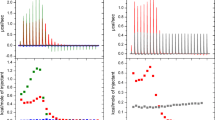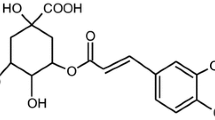Abstract
Cyclic peptides isolated from the plants of the Euphorbiaceae family have been largely studied due to their rigid conformation, which is considered significant for biologic activity. The peptide Labaditin (L0) and its open chain analogs (L1) were synthesized by the solid-phase peptide synthesis technique (Fmoc/tBu), and purified to elucidate its interaction with membrane models. A shift in λmax emission and Stern–Volmer constants values indicate that both tryptophans migrate to a more apolar environment, with L1 decreasing less than L0. A circular dichroism (CD) study revealed that L0 was kept unstructured in aqueous media as much as in the presence of dipalmitoilphosphatidylcholine liposomes. The thermodynamic studies by differential calorimetry (DSC) show a ΔH increase (50 and 18 kcal/mol, for L0 and L1, respectively) with peptide concentrations, which is indicative of lipids associating with peptides, resulting in the inability of the lipids to participate in the main transition. Therefore, all CD, DSC, and fluorescence data suggest a greater L0 membrane insertion. A probable mechanism for Labaditin interaction is based initially on the hydrophobic interaction of the peptide with the lipid membrane, conformational change, peptide adsorption on the lipid surface, and internalization process. Peptide’s antibacterial effect was also evaluated and revealed that only L0 showed reduction in viability in Gram-positive bacteria while no effects to the Gram-negative.







Similar content being viewed by others
References
Abuja PM, Zenza A, Trabib M, Craikb DJ, Lohner K (2004) The cyclic antimicrobial peptide RTD-1 induces stabilized lipid-peptide domains more efficiently than its open-chain analogue. FEBS Lett 566:301–306
Aké RC, Rejón GE, Pat MF, Rodriguez LMP, Sanchez SRP (2004) Bioactive terpenoids from roots and leaves of Jatropha gaumeri. Soc Quim Mex 48:11–14
Anderluh G, Barlic A, Podlesek Z, Macek P, Pungercar J, Gubensek F, Zecchini ML, Dalla SM, Menestrina G (1999) Cysteine-scanning mutagenesis of an eukaryotic pore-forming toxin from sea anemone-topology in lipid membranes. Eur J Biochem 263:128–136
Andersson D, Carlsson U, Freskgard P (2001) Contribution of tryptophan residues to the CD spectrum of the extracellular domain of human tissue factor. Eur J Biochem 268:1118–1128
Atherton E, Shepard RC (1989) Solid phase peptide synthesis: a practical approach. IRL Press, Oxford
Auvin C, Baraguey C, Blond A, Lezenven F, Pousset JL, Bodo B (1997) Curcacycline B, a cyclic nonapeptide from Jatropha curcas enhancing rotamase activity of cyclophHin. Tetrahedron Lett 38:2845–2848
Auvin-Guette C, Baraguey C, Blond A, Xavier HS, Pousset JL, Bodo B (1999) Pohlianins A, B and C, cyclic peptides from the latex of jatropha pohliana ssp. molissima. Tetrahedron Lett 55:11495–11510
Baraguey C, Guette CA, Blond A, Cavelier F, Lezenven F, Pousset JL, Bodo B (1998) Isolation, structure and synthesis of chevalierins A, B and C, cyclic peptides from the latex of jatropha chevalieri. J Chem Soc 1:3033–3039
Calderon LA, Silva-Jardim I, Zuliani JP, Silva AA, Ciancaglini P, Silva LHP, Stábeli RG (2009) Amazonian biodiversity: a view of drug development for leishmaniasis and malaria. J Braz Chem Soc 20:1011–1023
Castro MS, Ferreira TCG, Cilli EM, Crusca E, Mendes-Giannini MJS, Sebben A, Ricart CA, Sousa MV, Fontes W (2009) Hylin a1, the first cytolytic peptide isolated from the arboreal South American frog Hypsiboas albopunctatus (‘‘spotted treefrog’’). Peptides 30:291–296
Chattopadhyay A, London E (1987) Parallax method for direct measurement of membrane penetration depth utilizing fluorescence quenching by spin-labeled phospholipids. Biochemistry 26:39–45
Chen Y, Barkley MD (1998) Toward understanding tryptophan fluorescence in proteins. Am Chem Soc 37:9976–9982
Choo-Smith LP, Surewicz WST (1997) The interaction between Alzheimer amyloid β(1–40) peptide and ganglioside GM1-containing membranes. FEBS Lett 402:95–98
Christiaens B, Symoens S, Vanderheyden S, Engelborghs Y, Joliot A, Prochiantz A, Vandekerckhove J, Rosseneu M, Vanloo B (2002) Tryptophan fluorescence study of the interaction of penetratin peptides with model membranes. Eur J Biochem 269:2918–2926
Craik DJ, Daly NL, Bond T, Waine C (1999) Plant cyclotides: a unique family of cyclic and knotted proteins that defines the cyclic cystine knot structural motif. J Mol Biol 294:1327–1336
Daly NL, Koltay A, Gustafson KR, Boyd MR, Casas-Finet JR, Craik DJ (1999) Solution structure by NMR of circulin A. J Mol Biol 285:333–345
Dave PC, Billington E, Pan Y, Straus SK (2005) Interaction of alamethicin with ether-linked phospholipid bilayers: oriented circular dichroism, 31P solid-state NMR, and differential scanning calorimetry studies. Biophys J 89:2434–2442
Deber CM, Li S (1995) Peptides in membranes: helicity and hydrophobicity. Biopolymers 37:295–318
Deva MSZW, Behere DV (1999) Fluorescence and circular dichroism spectroscopic studies on bovine lactoperoxidase. Biometals 12:219–225
Eftink MR, Ghrion CA (1976) Exposure of tryptophanyl residues in proteins. Quantitative determination by fluorescence quenching studies. Biochemistry 15:672–680
Goulart RC, Bolean M, Paulino TP (2009) Photodynamic therapy in planktonic and biofilm cultures of aggregatibacter actinomycetemcomitans. Photomed Laser Surg. doi:10.1089/pho.2009.2591
Grishina IB, Woody RW (1994) Contributions of tryptophan side chains to the circular dichroism of globular proteins: exciton couplets and coupled oscillators. Faraday Discuss 99:245–262
Huang HW (2000) Action of antimicrobial peptides: two-state model. Biochemistry 39:8347–8352
Kelkar DA, Chattopadhyay A (2006) Monitoring ion channel conformations in membranes utilizing a novel dual fluorescence quenching approach. Biochem Biophys Res Commun 353:483–488
Kelly SM, Price NC (2000) The use of circular dichroism in the investigation of protein structure and function. Curr Protein Pept Sci 1:349–384
Kelly SM, Jess TJ, Price NC (2005) How to study proteins by circular dichroism. Biochim Biophys Acta 1751:119–139
Kosasi S, Vandersluis WG, Boelens R, Thart L, Labadie RPL (1989) Labaditin A novel cyclic decapeptide from the latex of jatropha-multifida (Euphorbiaceae). FEBS Lett 256:91–96
Kun H, Minnes R, Mastai Y (2008) Effects antifreeze peptides on the thermotropic properties of a model membrane. J Bioenerg Biomembr 40:389–396
Kwon YU, Kodadek T (2007) Quantitative comparison of the relative cell permeability of cyclic and linear peptides. Chem Biol 14:671–677
Ladokhin AS, Jayasinghe S, White SH (2000) How to measure and analyze tryptophan fluorescence in membranes properly and why bother? Anal Biochem 285:235–245
Lakowicz JR (2006) Principles of fluorescence spectroscopy, 3rd edn. Springer, New York, p 395
Lohner K, Staudegger E, Prenner EJ, Lewis RN, Kriechbaum M, Degovics G, McElhaney RN (1999) Effect of staphylococcal delta-lysin on the thermotropic phase behavior and vesicle morphology of dimyristoylphosphatidylcholine lipid bilayer model membranes. Differential scanning calorimetric, 31P nuclear magnetic resonance and Fourier transform infrared spectroscopic, and X-ray diffraction studies. Biochemistry 38:16514–16528
Menezes H, Jared C (2002) Immunity in plants and animals: common ends through different means using similar tools. Comp Biochem Physiol 132:1–7
Merrifield RB (1963) Solid phase peptide synthesis: synthesis of a tetrapeptide. J Am Chem Soc 85:2149–2154
Nakamura M, Sekino-Suzuki N, Mitsui K, Ohno-Iwashita Y (1998) Contribution of tryptophan residues to the structural changes in perfringolysin O during interaction with liposomal membranes. J Biochem 123:1145–1155
Park NG, Yamato Y, Lee S, Sugihara G (1995) Interaction of mastoparan-B from venom of a hornet in Taiwan with phospholipid bilayers and its antimicrobial activity. Biopolymers 36:793–801
Paulino TP, Ribeiro KF, Thedei G Jr, Tedesco AC, Ciancaglini P (2005) Use of hand held photopolymerizer to photoinactivate Streptococcus mutans. Arch Oral Biol 50:353–359
Pedersen TB, Frokjaer S, Mouritsen OG, Jørgensen K (2002) A calorimetric study of phosphocholine membranes mixed with desmopressin and its diacylated prodrug derivative (DPP). Int J Pharm 233:199–206
Powl AM, East MJ, Lee AG (2003) Lipid-Protein interactions studied by introduction of tryptophan residue: the mechanosensitive channel MscL. Biochemistry 42:14306–14317
Reddy KVR, Yedery RD, Aranha C (2004) Antimicrobial peptides: premises and promises. Int J Antimicrob Agents 24:536–547
Rezai T, Bock JE, Zhou MV, Kalyanaraman C, Lokey RS, Jacobson MP (2006a) Conformational flexibility, internal hydrogen bonding, and passive membrane permeability: successful in silico prediction of the relative permeabilities of cyclic peptides. J Am Chem Soc 128:14073–14080
Rezai T, Yu B, Millhauser GL, Jacobson MP, Lockey S (2006b) Testing the conformational hypothesis of passive membrane permeability using synthetic cyclic peptide diastereomers. Am Chem Soc 128:2510–2511
Ridder A, Shupjen P, Unterreitmeier S, Langosch D (2005) Tryptophan supports interaction of transmembrane helices. J Mol Biol 354:894–902
Sahu S, Behera PK (2008) Fluorescence quenching of 2-naphthol by methyl acrylamide in micellar medium. Indian J Chem 47A:1516–1519
Seelig J (2004) Thermodynamics of lipid-peptide interactions. Biochim Biophys Acta 1666:40–50
Sforça ML, Machado A, Figueredo RCR, Oyama S Jr, Silva FD, Miranda A, Dafre S, Teresa M, Miranda M, Spisni A, Pertinhez TA (2005) The micelle-bound structure of antimicrobial peptide derived from the α-chain of bovine hemoglobin isolated from the tick Boophilus microplus. Biochemistry 44:6440–6451
Shin SY, Lee SH, Yang ST, Park EJ, Lee DG, Lee MK, Eom SH, Song WK, Kim Y, Hahm KS, Kim JI (2001) Antibacterial, antitumor and hemolytic activities of α-helical antibiotic peptide, P18 and its analogs. J Pept Res 58:504–514
Simão AMS, Ciancaglini P, Yadav MC, Narisawa S, Bolean M, Pizauro JM, Hoylaerts MF, Millán JL (2010) Proteoliposomes harboring alkaline phosphatase and nucleotide pyrophosphatase as matrix vesicles’ biomimetics. J Biol Chem 285:7598–7609
Sitaram N, Chandy M, Pillai VNR, Nagaraj R (1992) Change of glutamic acid to lysine in a 13-residue antibacterial and hemolytic peptide results in enhanced antibacterial activity without increase in hemolytic activity. Antimicrob Agents Chemother 36:2468–2472
Sospedra P, Mestres C, Haro I, Munõz M, Busquets MA (2002) Effect of amino acid sequence change on peptide-membrane interaction. Am Chem Soc 18:1231–1237
Tan NH, Zhou J (2006) Plant cyclopeptides. Chem Rev 106:840–895
Thennarasu S, Nagaraj R (1996) Specific antimicrobial and hemolytic activities of 18 residue peptides derived from the amino terminal region of the toxin pardaxin. Protein Eng 9:1219–1224
Torchilin VP (2004) Polymeric immunomicelles: carriers of choice for targeted delivery of water-insoluble pharmaceuticals. Polymeric Immunomicelles 4:63–68
Van Der Wel PCA, Reed ND, Greathouse DV, Koeppe RE (2007) Orientation and motion of tryptophan interfacial anchors in membrane spanning peptides. Biochemistry 46:7514–7524
Woody RW (1996) Theory of circular dichroism of protein. In: Fasman GD (ed) Circular dichroism and the conformational analysis of biomolecules, chap 2. Plenum Press, New York, pp 25–68
Xiao Q, Pei D (2007) High-Throughput synthesis and screening of cyclic peptide antibiotics. J Med Chem 50:3132–3137
Yang JJ, Pitkeathly M, Radford SE (1994) Far-UV circular dichroism reveals a conformational switch in a peptide fragment from the β-Sheet of hen lysozyme. Biochemistry 33:7345–7353
Zhang XP, Zhang ML, Su AH, Huo CH, Gu YC, Shi QW (2009) Chemical constituents of the plants from genus Jatropha. Chem Biodivers 6:2166–2183
Acknowledgments
The authors are grateful to Conselho Nacional de Desenvolvimento Científico e Tecnológico (CNPq), Fundação ao Amparo a Pesquisa do Estado de São Paulo (FAPESP), Coordenação de Aperfeiçoamento de Nível Superior—Projeto NanoBiotec (CAPES) for financial support and Priscila Cerviglieri for linguistic advice. PC, EMC and RGS are senior researchers of the CNPq, and SCB was the recipient of Master fellowship from FAPESP.
Author information
Authors and Affiliations
Corresponding author
Electronic supplementary material
Below is the link to the electronic supplementary material.
Rights and permissions
About this article
Cite this article
Barbosa, S.C., Cilli, E.M., Dias, L.G. et al. Labaditin, a cyclic peptide with rich biotechnological potential: preliminary toxicological studies and structural changes in water and lipid membrane environment. Amino Acids 40, 135–144 (2011). https://doi.org/10.1007/s00726-010-0648-6
Received:
Accepted:
Published:
Issue Date:
DOI: https://doi.org/10.1007/s00726-010-0648-6




